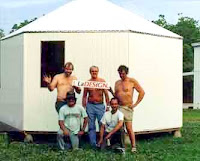
 Thanks to a generous fund provided by Private Capital Inc. and it's owner, Ronald Smith (left on photo), the Archimede Institute has fully tested a series of small buildings that can be erected in a few hours. The one shown here is an aseptic field operating room that is air conditioned and can be hosed down clean inside and out. The heaviest component weighing in at 30 kilos, two nurses could theoretically put one up on their lunch break, to use a little Cajun exageration. The entire package can be air freighted in a small crate that fits in any air cargo hold.
Thanks to a generous fund provided by Private Capital Inc. and it's owner, Ronald Smith (left on photo), the Archimede Institute has fully tested a series of small buildings that can be erected in a few hours. The one shown here is an aseptic field operating room that is air conditioned and can be hosed down clean inside and out. The heaviest component weighing in at 30 kilos, two nurses could theoretically put one up on their lunch break, to use a little Cajun exageration. The entire package can be air freighted in a small crate that fits in any air cargo hold. Note: Photo taken on a hot day after a few Cajun beers. ;-) I'm the sober one on the right.
Jacques

